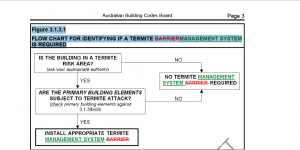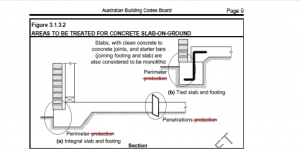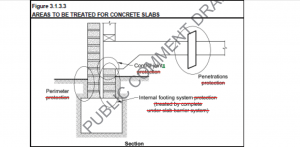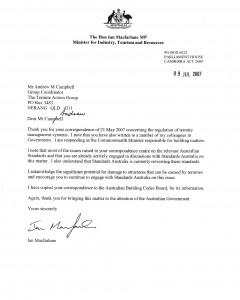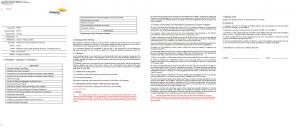Imagine both the Australian Building Codes Board (ABCB) Building Code of Australia (BCA) and Standard Australia’s referenced Australian Standard (AS 3660.1 – 2000) for New Building Work Termite Management both describing termite management systems as termite barriers and, the BCA providing advice that these termite barriers provide termite protection when they can be walked over within minutes by termites!
Even worse, what if our premier research institution – i.e. The CSIRO – established the basis for this situation by providing Technical Appraisals that fast-tracked their usage and defined these termite systems as termite barriers under flawed testing regimes.
To further compound the problem, what if the ACCC (The Consumer Representative) was being provided with irrefutable facts about a multitude of failures of these supposed termite barriers and being unable to act on behalf of Consumers because of the provisions held in the BCA and the referenced Standards.
Detailed herein are the respective roles of the ABCB, Standards Australia, the ACCC and the CSIRO complete with minutes of important meetings, letters, submissions and reports that clearly detail the monumental failures of these bureaucracies to deal with a burgeoning problem at an earlier juncture to waylay the ominous circumstances that threaten the homes of hundreds of thousands of ordinary Australian homeowners.
What occurred in real terms was that organisations, supposedly dedicated to public interest, were actually working in direct opposition to the welfare of ordinary Australian homeowners!
These organisations included the ABCB, Standards Australia, the ACCC and the CSIRO among others!
This represented a sustained endemic and systemic breakdown of a system supposedly designed to protect the homes and residences of ordinary Australian Homeowners which, in effect, put at perpetual risk what represents the largest private investment portfolio in Australia.
Extensive advice was provided by TAG to all of these organisations during a period spanning several years.
The TAG advice clearly and concisely demonstrated the case in point via the use of diagrams, documentation, submissions, lectures and power-point presentations to irrefutably destroy the ‘Termite Barrier” contention.
Both the ABCB and Standards Australia failed extensively in their public duty to act in protecting the public welfare by :-
- Initially providing provisions in the BCA and Standards for termite management systems to be considered as termite barriers
- Allowing these provisions to stand after being made aware by TAG that the systems were unable to perform that function
- Neglecting to amend the provisions in a timely fashion after TAG advice clearly dispelled the termite barriers contention
- Allowing ordinary Australian homeowners to be subjected to these onerous provisions for over fourteen years
- Putting what represents most ordinary Australians’ largest asset at sustained and continuous risk over its entire life-span
- Working against the national interest and failing in their public duty to amend these onerous provisions in a timely fashion
The ABCB, Standards Australia, the CSIRO and the ACCC all failed in their fiduciary obligations to the Australian Public by either being involved in providing, confirming, entrenching and supporting these unworkable provisions and/or failing to take issue with the problem once it had been exposed for the fraud that it obviously represented to the Australian Public.
Finally, after seven years, the ABCB has caused Standards Australia to review and revamp the provisions in its new edition of the Standard (AS 3660.1 – 2014) in line with changes affected to the BCA.
TAG is advised the new edition of the Standard will be published in August 2014 and referenced by the 2015 BCA Edition due for release in May 2015. The following documents and advice will provide verification and galvanise the extraordinary claims made herein.
The ABCB and the BCA
The circumstance whereby the latest version of the BCA is still referencing the AS 3660.1 – 2000 version of the Termite Management Standard – New Building Work will continue to occur until May 2015 based on advice provided to TAG by the Building Codes Committee (BCC).
What this means to ordinary Australian homeowners is that fifteen years of constructed homes, equating to well over three million residential properties, will have been constructed under false and misleading provisions that nominate a “Barrier Status” for termite management products and systems that can be ‘bridged’ within minutes.
The BCA has now finally made changes as per the draft provisions set out below in information and diagrams clearly demonstrating the loss of ‘Termite Barriers’ and subsequent ‘Termite Protection’. (See Below Images)
Click on images to enlarge
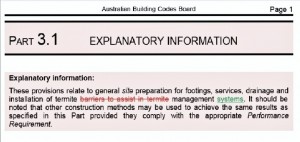
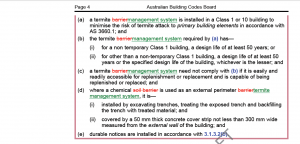
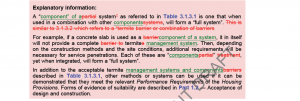 The above excerpts evidence the changes to the BCA with red text indicating pre-existing text that is being removed from the BCA and green text indicating new text added to the BCA.
The above excerpts evidence the changes to the BCA with red text indicating pre-existing text that is being removed from the BCA and green text indicating new text added to the BCA.
Changes to the BCA shown in these drafts clearly indicate that the ‘Termite Barrier(s)’ that were previously on offer via the auspices of the BCA provisions are now reduced to ‘Termite Management Systems’ and ‘Components’ thereof!
Further changes to the BCA further indicate a complete ‘Loss of Protection’ previously afforded to these supposed ‘Termite Barriers’!
This is clearly indicated in the changes to existing diagrams in the BCA where the loss of the ‘Termite Barrier’ & subsequent ‘Protection’ becomes self-evident from the changes therein.
(See Below Images)
Click on images to enlarge
Click on image to enlarge
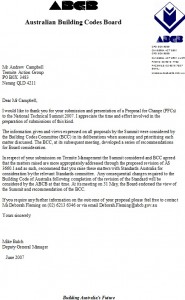 The Australian Building Codes Board (ABCB) has been in denial for years on these matters and has continued to allow the BCA to misrepresent the facts to ordinary Australian homeowners over an extended period of time whilst having been provided with full knowledge of the circumstance by TAG in a Proposal for Change provided to the ABCB in February 2007 which was presented upon at length via a power-point presentation at the ABCB National Technical Summit in Hahndorf, South Australia in early 2007.
The Australian Building Codes Board (ABCB) has been in denial for years on these matters and has continued to allow the BCA to misrepresent the facts to ordinary Australian homeowners over an extended period of time whilst having been provided with full knowledge of the circumstance by TAG in a Proposal for Change provided to the ABCB in February 2007 which was presented upon at length via a power-point presentation at the ABCB National Technical Summit in Hahndorf, South Australia in early 2007.
A letter from the ABCB received in June of 2007 states therein that : “In respect of your submission on Termite Management the Summit considered and the Building Codes Committee (BCC) agreed that the matters raised are more appropriately addressed through the proposed revision of AS 3660.1 and as such, recommend that you raise these matters with Standards Australia for consideration by the relevant Standards committee.
Any consequential changes required to the Building Code of Australia following completion of the revision of the Standard will be considered by the ABCB at that time. At its meeting on 31 May 2007, the Board endorsed the view of the summit and recommendation of the BCC”.
Click on image of letter to enlarge
A letter was received from the Federal Minister with the responsibility for building matters at that time (The honourable Ian Macfarlane MP) which in part states that he was in receipt of previous correspondence from TAG and that several of his colleagues had also been in receipt of similar correspondence.
The Minister noted, erroneously or otherwise, that most of the issues raised centred on the relevant Australian Standards and understood that TAG was at that time actively engaged in discussions with the Standards Australia on this matter.
The Minister further noted that Standards Australia were currently reviewing these Standards and added that he acknowledged the significant potential for damage to structures that could be caused by termites and encouraged the TAG to continue to engage with Standards Australia on this issue.
The Minister, after a protracted period of opposition, has now been returned and reinstated to his former position in having, once again, the responsibilities for these matters which have clearly been neglected by both the ABCB & Standards Australia.
We now turn to the respective role of Standards Australia and the Standards committee (BD-074) responsible for the debacle that involves the Building Code of Australia (BCA) referencing an entirely inaccurate Standard (AS 3660.1 – 2000 Termite Management – New Building Work) which fails the public welfare test on all counts.
Standards Australia and the Termite Management Standards (AS 3660 Series)
In discussing the Standard, we need to understand the composition and workings of a Standards committee, the representatives thereon and the means by which Standards are composed and formulated prior to release into the public domain.
From the outset, and by way of explanation, the BD-074 committee responsible for the composition and subsequent reviews of the Termite Management Standards, inclusive of both past and present members thereon, was inherently corrupted in primarily representing the pecuniary interests of commercial entities.
AS 3660.1 dealt exclusively with preconstruction termite management – i.e. New building work – and the BD-074 had prescriptively-listed products in the Standard. TAG advised the BD-074 that Standards must be performance-based and NOT prescriptive documents – i.e. Set a performance criteria in the Standard whereby a product or a system must prove itself able to perform its function as to the criteria provided therein.
Double Click on Image to enlarge
Unfortunately, not only did the BD-074 prescriptively-list products and systems in AS 3660.1 – 2000; they prescribed these systems as termite barriers when, in effect, they could be ‘bridged’ in minutes and inspections were generally an annual event.
The minutes provided herein attest to the BD-074 being in denial and requesting a letter from the ACCC to provide feedback on concerns that the ACCC might have with AS 3660.1 and problems with the barrier status conferred on termite management systems.
An extraordinary meeting, as is referenced in the BD-074 minutes, had been called by the General Manager of the ABCB to review the situation that had been outlined to him by TAG at his Canberra office with a subsequent extensive Submission provided by TAG to fully outline the size and extent of the problems in preconstruction management. (Click Here to see the Submission)
The BD-074 were simply saying, “Problem, What Problem? The Standards are Technically Correct!” Herein lay the problem! Standards Australia representatives backed the BD-074 in their wrongful assertions! The ABCB knew the BD-074 was wrong but continued to have the BCA reference the Standard – AS 3660.1 – 2000.
THE BUILDING CODES COMMITTEE (BCC)
The extraordinary meeting occurred at the ACCC Brisbane board-room and was convened four months prior to the meeting with Standard Australia’s BD-074 and it can be readily evidenced that the minutes for each meeting differed significantly in their content and understanding of what was occurring in pre construction termite management.
Click on Image to enlarge
 The meeting with members of the Building Codes Committee (BCC) clearly demonstrated the frustration that they held in relation to the BD-074 and the Standard (AS 3660.1 – 2000) in providing misleading and spurious advice pertaining to preconstruction termite management systems.
The meeting with members of the Building Codes Committee (BCC) clearly demonstrated the frustration that they held in relation to the BD-074 and the Standard (AS 3660.1 – 2000) in providing misleading and spurious advice pertaining to preconstruction termite management systems.
There is advice provided in the minutes for the meeting held in the ACCC board-room in Brisbane stated therein that both the ABCB and TAG had approached Standards Australia on several occasions to amend various aspects of the Standard with promises provided but no action undertaken.
Clearly, both the ABCB and TAG were not happy, given these circumstances.
The BD-074 were clearly in denial claiming in their meeting minutes that all members of the BD-074 were unanimous in their belief that the Termite Management Standards were not technically incorrect. As can be also noted in their meeting minutes, the BD-074 further requested a letter from the ACCC be provided to the committee outlining “……….. their dissatisfaction of the word ‘BARRIER’ and their reasoning for it”.
The ACCC
A letter from the ACCC was provided to the BD-074 with fourteen questions therein that were penned for the ACCC by TAG to elicit YES/NO responses that would clearly define whether the ‘Barrier Status’ was applicable to termite management systems and especially to systems prescriptively-listed in the Standard.
The ACCC was unable to get a reply or response from the BD-074, or indeed any other party, in relation to providing answers to the questions posed by TAG. The letter from the ACCC provided questions that, in providing honest accurate answers thereunto, tore to pieces any shred of advice that might contend these products and systems were, in fact, ‘termite barriers’.
For the BD-074 to maintain such a position proved they were either corrupt and/or exceedingly inept! Read the ACCC Letter below and you be the judge!
Double Click on Image to enlarge 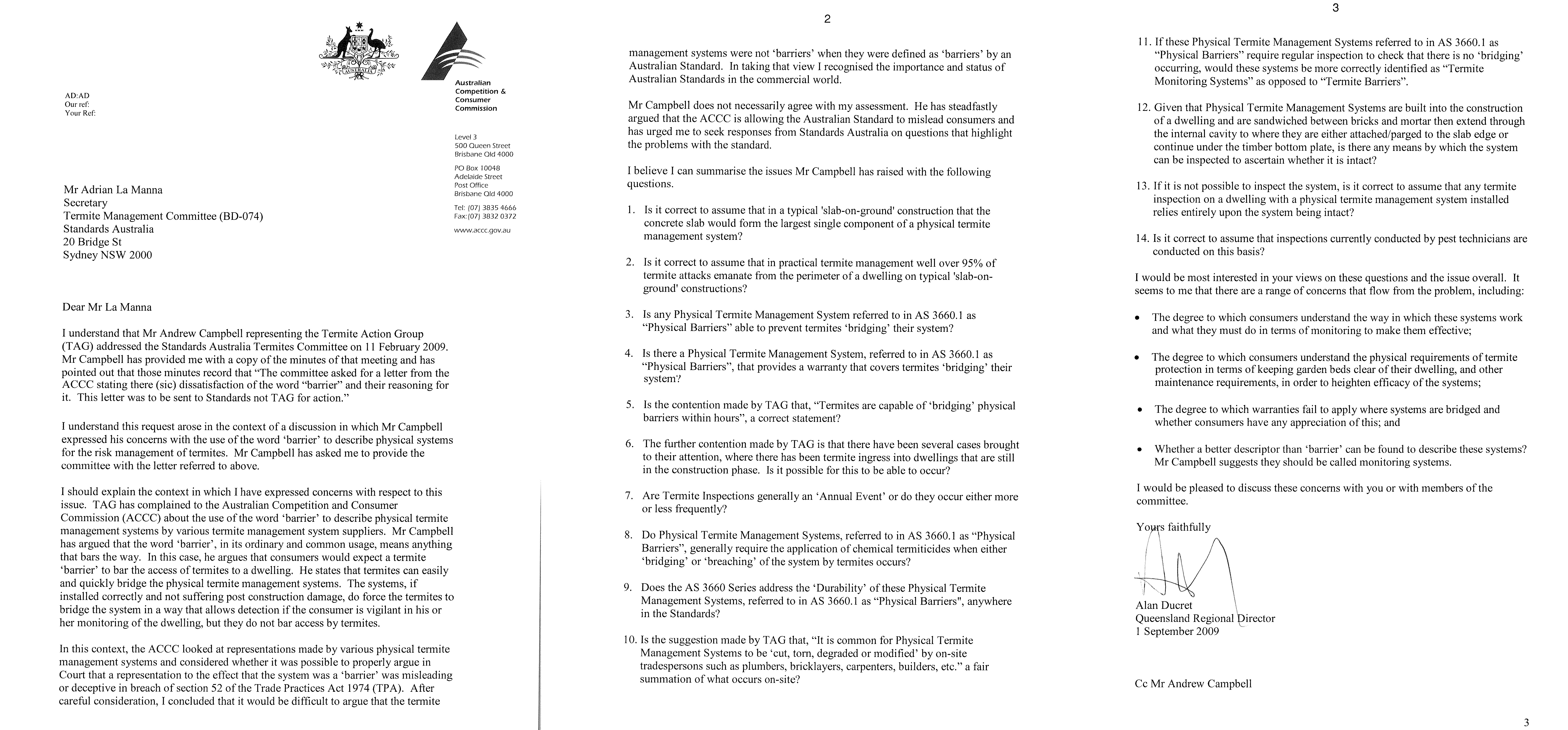
The ACCC were to later advise TAG that despite the fact that the BD-074 Standards committee requested the letter from the ACCC, the BD-074 were NOT REQUIRED to provide answers to the questions or to provide an answer to the letter and, that the ACCC was unable to compel the BD-074 to provide an answer!
The BD-074 did not answer the ACCC Letter which demonstrated the contempt they held for the public interest! It also demonstrates, yet again, the fact that the ACCC is a ‘toothless tiger’ that is clearly unable to perform its function in upholding and protecting the rights of the Consumer!
Sad, but true!
In 2012, the chairperson of the BD-074 was to partially answer the questions in the ACCC Letter in a Scientific Paper provided to the International Research Group (IRG) on Wood Protection curiously headed “Managing Termite Risks – An Australian Perspective and a Cautionary Tale” in which he provides the following advice pertaining to supposed termite barriers being designed to deter concealed access being achieved by termites – i.e. “This seems to be an inadequate provision, since it takes a single termite less than a minute to travel from the ground and up the exterior wall to a weep-hole in masonry or some similar entry point”.
Despite his knowledge of this circumstance, the Chairperson of the BD-074 was the most ardent supporter of retaining the ‘Barrier Status’ of termite management systems that were clearly, by his own advice, unable to perform this function!
Standards Australia should immediately remove ALL members on this corrupt and inept committee that has caused many homes to be constructed with little or no termite protection. Clearly, the BD-074 provided disparate advice with claims that ‘Termite Barriers’ were being provided to constructed dwellings under the false, misleading and disingenuous provisions in the Standard.
Where and what was the basis for the claim of ‘Barrier’ as applied to these termite management systems?
The CSIRO
In 1999, to much fanfare, the CSIRO announced a new service for the approval of innovative building products that was supposed to assist manufacturers, builders and consumers discussed as “CSIRO Appraisals“.
In the Media Announcement CSIRO representatives trumpeted the advice that the CSIRO had effectively absorbed the role of the Australian Building Systems Appraisal Council (ABSAC) that had been in operation since 1978.
Supposedly, the CSIRO Appraisal system launched in March 1999 was designed to fast track novel new building systems and provided a service whereby building product and system manufacturers were able to have their products and systems judged fit for their intended purpose and subsequently get approval from regulators such as the Australian Building Codes Board (ABCB).
Nearly all of the CSIRO Appraisals were applied to termite management products and systems and invariably they were nominated in the CSIRO Appraisal as ‘Termite Barriers’ and/or had the word ‘Barrier’ utilised in their title description – e.g. : KTB (Kordon Termite Barrier).
Whilst this was presented in the CSIRO Press Release (See Below) as a Win-Win situation for all parties, the reality was that for the end users of these products and systems, this was to become an unmitigated disaster!
After extensive consultation with the CSIRO with regards to the Technical Appraisals provided to numerous termite management products and systems discussed as termite barriers therein, the TAG sought answers from the CSIRO as to how the ‘Termite Barrier’ status was acquired and what testing had been performed to establish the products and systems were barriers to termites.
It soon became apparent that little real testing was undertaken and that the testing that was performed had utilised protocols that eliminated ‘bridging access’ by either directing termite movement through glass stems or encased timber in materials deemed to be termite barriers.
In effect, the CSIRO testing protocols were extensively flawed in utilising systems on an ad infinitum basis when, in fact, the systems were practicably applied as finite systems – i.e. To utilise the system as per the testing regime, you would need to encapsulate the entire house in the material and deny access to the Homeowner.
After many queries to scientists, the CSIRO board and the Federal Minister responsible for the CSIRO; TAG finally received answers to some of its queries in a letter.
(See CSIRO Report Below click on image to enlarge)
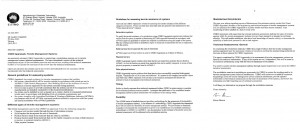 As can be readily noted in the CSIRO Letter, the word ‘Barrier’ is used extensively to describe termite management products and systems whilst the CSIRO concedes that NO TESTING was undertaken to ascertain the durability of the termite management systems.
As can be readily noted in the CSIRO Letter, the word ‘Barrier’ is used extensively to describe termite management products and systems whilst the CSIRO concedes that NO TESTING was undertaken to ascertain the durability of the termite management systems.
The CSIRO addressed this by having system and product manufacturers provide advice that their systems and products had a ‘design life’ of fifty years whilst advising the manufacturers that this advice did not impact upon their warranty provisions.
Despite the advice in the CSIRO Report that the CSIRO would keep the TAG informed as they progressed through the revalidation exercise, no further correspondence or oral advice was received and about a year after the provision of this correspondence, the entire Technical Appraisal Scheme was ingloriously shut down and the CSIRO got completely out of providing any further Technical Appraisals.
Monies were even refunded to applicants with products and systems undergoing analysis for the onward provision of a Technical Appraisal for their products and/or systems. It is further interesting to note the extensive use of the word ‘BARRIER’ in the CSIRO correspondence and the inalienable fact that both the Standards and the BCA have since REMOVED the word in its entirety where it applies to termite management systems.
The CSIRO has NEVER either properly tested or proven the BARRIER STATUS of any of the systems that it provided Technical Appraisals discussing termite management systems and products as Termite Barriers!
The CSIRO has entirely failed in its role throughout this sordid circumstance and largely assisted in contributing to the detriment of the homes of ordinary Australian Homeowners by endorsing products and systems as termite barriers when these products and systems were absolutely incapable of performing this function!
Expired CSIRO (ABSAC) Appraisals are still relied upon by termite management systems and products suppliers and manufacturers to provide substance to their spurious ‘termite barrier’ claims made to unsuspecting homeowners.
The CSIRO has failed in its public duty and has misrepresented termite management systems and products to negatively impact on the public welfare throughout this entire circumstance.
IN CLOSING
The failure of the ABCB and Standards Australia in providing the Building Code of Australia (BCA) and the Standard (AS3660.1-2000) respectively that failed the primary provision of the BCA (Part 1.2 ACCEPTANCE OF DESIGN AND CONSTRUCTION & Part 1.2.1.Suitability of Materials) which requires that “Every part of a building must be constructed in an appropriate manner to achieve the requirements of the ‘Housing Provisions’, using materials that are fit for the purpose which they are intended”.
Clearly the materials used were NOT fit for purpose as barriers to termites!
The fact that these products and systems are now listed as termite management systems in both the BCA, now discussed as the National Construction Code (NCC), and the Standard is of further concern.
How do these termite management systems ‘manage’ would be the question!
Given the absolute fact that termites can ‘bridge’ these management systems in minutes, or in the words of the chairperson of the BD-074 Standards committee, “…………..it takes a single termite less than a minute to travel from the ground and up the exterior wall to a weep-hole in masonry or some similar entry point” ; then the suggestion would be that these systems manage very poorly indeed!
Further, in Part 1.2.2 of the BCA headed Evidence of Suitability, which requires evidence to support the use of a material – i.e. a termite barrier; such as a certificate or a report.
As we now know, this was generally a CSIRO (ABSAC) Technical Appraisal that contended these systems were ‘Termite Barriers’!
The ACCC was asked to review this extraordinary circumstance. They simply advised that they were unable to compel Standards Australia to answer the questions in their letter!
Remarkable, but true!
Many hundreds of thousands of homes have been constructed utilising these ridiculously unworkable provisions and many of the hundreds of thousands of homes have been constructed since 2007 when the ABCB and Standards Australia were first formally advised of this circumstance.
Is this the bureaucracy that Australians really deserve and will they ever be accountable?
Standards Australia and the BD-074 have fought these changes to the bitter end. Why?
The ABCB and TAG worked hard to have them finally address the matter.
In New Zealand, James Hardie recently settled a 1.5 Billion Dollar court action out of court with the New Zealand Education Dept. relating to ‘leaky home syndrome’ whereby external cladding affixed to buildings was unable to perform the function for which it was designed by allowing water to ingress through a supposedly waterproof barrier into the structure to cause structural failure due to fungal activity.
In this case we have termite ingress through supposed termite barriers to cause structural failure due to termite activity.
If someone can explain the difference between a situation where one party provides a moisture barrier that fails and another party providing a termite barrier that fails – I would certainly be interested!
One is moisture ingress and the other is termite ingress and in both cases the ingress leads ultimately to structural failure.
Methinks that there may well be a case to answer!
A CLASS ACTION.
UNDER CONSTRUCTION
whilst parading their interests as well-founded, intelligent understandings of termite management methodology in the inter-relationship pertaining to building structures.
The chairperson of the Standards committee that is responsible for the Standard advises in respect of termite barriers being designed to deter concealed access that “This seems to be an inadequate provision, since it takes a single termite less than a minute to travel from the ground and up the exterior wall to a weep-hole in masonry or some similar entry point”. The advice was tendered in an IRG Paper headed “Managing Termite Risks – An Australian Perspective and a Cautionary Tale”. In less than a minute, a termite could be in position to walk over a supposed termite barrier! “How is it a termite barrier?” you may well ask! Clearly, it is not! Many hundreds of thousands of homes have been constructed since 2000 when both the BCA and the Standard first provided these ridiculous provisions that put the homes of ordinary Australians at continual and ongoing risk of termite attack throughout their entire life. Just when you think it could not get any worse, the CSIRO validated the termite barrier status of these termite systems through the ABSAC Technical Assessment/Appraisal System using inane experiments to justify their logic. How could this happen, you may well ask! Simply put, you are able to fence cattle as they move on a horizontal plane and can only free themselves of the confinement of a fence by either breaking through (i.e. ‘breaching’) the fence or somehow getting over (i.e. ‘bridging’) the top of the fence. The notion of fencing termites out of a structure was doomed from the outset! Why? Termites can travel horizontally, vertically and upside down if needs be to get to a food source. The CSIRO was compromised by commercial inducements and failed to provide rational testing regimes that reflected the ‘bridging risks’ associated with the use of tested products in practical installations. In 2009, the CSIRO left the debacle of ABSAC Technical Assessments/Appraisals behind and departed the scene entirely after having a tilt at righting the matter by conducting a reassessment of products that had been previously assessed and requiring the manufacturers/providers to provide an undertaking that their termite systems/products had a ‘design life’ of fifty years which did not impact on their warranties. Scary, but true! It was patently obvious that neither the Australian Building Codes Board (ABCB) with the responsibility for the BCA and Standards Australia who provided the referenced Standard (AS 3660.1); nor the CSIRO who provided the ABSAC Technical Assessments/Appraisals had any real interest in the sustained massive fraud that was being perpetrated and perpetuated on unsuspecting ordinary Australian homeowners. The collective failures of the ABCB, Standards Australia and the CSIRO to address the problem and the continuing campaign to misrepresent the products and systems discussed as termite barriers was in direct opposition to advice provided to these institutions by TAG and proved irrevocably that these products/systems were ‘entirely unable to perform the function for which they were designed’ in direct defiance of a primary tenet of the BCA – Part 1.2 which deals with ‘Acceptance of Design and Construction’ – Part 1.2.1 ‘Suitability of Materials’ and Part 1.2.2 ‘Evidence of Suitability’ thereon. This circumstance has caused extensive costs to be borne by ordinary Australian homeowners who are inadvertent victims of the failures in the administration of the ABCB, Standards Australia and the CSIRO to address these matters at an earlier juncture given the extensive advice provided by TAG to all these agencies. (UNDER CONSTRUCTION)

